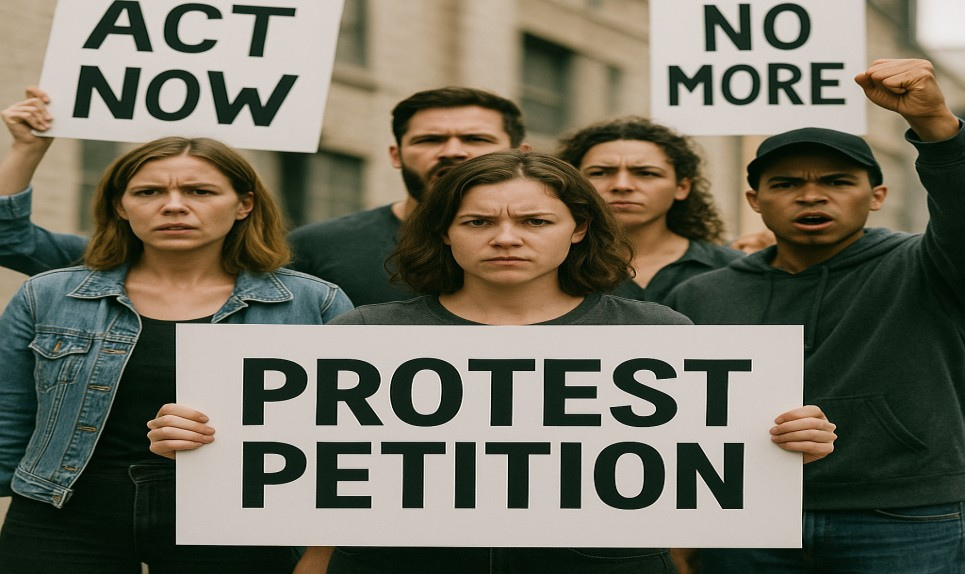Protest Petition under CrPC: When, Why and How to File

When the police file a closure or final report saying “no case is made out,” the complainant often feels helpless. Indian criminal procedure, however, gives that aggrieved person a powerful remedy: the protest petition. Though the Code of Criminal Procedure, 1973 (CrPC) does not use the phrase “protest petition,” courts across India have consistently recognised and shaped this remedy to protect victims’ rights and ensure that truth does not get buried under an erroneous investigation.
What Is a Protest Petition?
A protest petition is a written objection filed by the informant/complainant (or any person aggrieved by the police report) before the Magistrate after the police submit a final report/closure report under Section 173(2) CrPC. The petition requests the court not to accept the police’s conclusion and instead take cognizance of the offence, order further investigation, or proceed as a complaint case.
Put simply, it is the complainant’s way of telling the court, “I disagree with the police; please look at the material afresh or allow me to prove my case.”
When Does the Need Arise?
Typically, a protest petition is filed in any of the following situations:
The police file a Final Report (FR) or “B report,” stating that no offence is disclosed or evidence is insufficient.
Only a part of the complaint is accepted and serious sections are dropped.
Some accused are left out or shown as “not sent up for trial.”
The investigation is perfunctory, biased, or incomplete.
Statutory Foundation
While “protest petition” is judge-made terminology, the legal foundation lies in:
Section 173(2) CrPC – submission of final report by police.
Section 190 CrPC – Magistrate’s power to take cognizance upon “police report” or “complaint.”
Sections 200–203 CrPC – Procedure for complaint cases (examination of complainant and witnesses; dismissal of complaints).
Section 156(3)/173(8) CrPC – Ordering further investigation.
Victim rights provisions (e.g., Section 2(wa), proviso to Section 24(8) CrPC) – recognise an active role for victims.
Courts have harmonised these provisions to say: after a final report, the Magistrate must apply a judicial mind and can consider an objection by the informant; that objection is the protest petition.
Magistrate’s Options After a Final Report: The Bhagwant Singh Triad
In Bhagwant Singh v. Commissioner of Police (1985), the Supreme Court laid down that when a final report is placed before a Magistrate, three broad options exist:
Accept the report and close the case (after giving notice to the informant if the FIR was registered based on his information).
Disagree with the report and take cognizance of the offence under Section 190(1)(b) CrPC.
Order further investigation under Section 156(3) or 173(8) CrPC.
A protest petition usually urges the Magistrate to choose option 2 or 3.
Who Can File a Protest Petition?
Informant/Complainant: The person who lodged the FIR or complaint has the primary locus standi.
Victim or Next of Kin: Even if someone else lodged the FIR, the victim’s family can object.
Any aggrieved person whose rights are directly affected by the alleged offence.
Corporate entities, NGOs, or guardians can also file if they are the “person aggrieved.”
Essential Contents and Structure
A well-drafted protest petition should typically include:
Title and Case Details: FIR number, police station, sections invoked, name of Magistrate’s court, number of the final report.
Background Facts: Brief narration of original grievance and investigation history.
Grounds of Protest: Point-wise rebuttal of the police’s conclusions, highlighting ignored evidence, hostile witnesses, missing documents, forensic lapses, contradictions, etc.
Prayer/Relief Sought: Ask the court to (a) reject the final report, (b) take cognizance and issue process, or (c) order further investigation, or (d) treat the petition as a complaint under Sections 200–202 CrPC.
List of Documents/Evidence: Attach affidavits, medical records, photographs, CCTV footage, call records, etc.
Verification/Affidavit (if local practice requires): Though not mandatory everywhere, it adds credibility.
Engage a Legal Practitioner: Wherever possible, have the protest petition drafted or vetted by an experienced advocate (for instance, Advocate Subhash Ahlawat) to ensure procedural compliance, correct prayers, and persuasive reasoning.
Step-by-Step Procedure
Receipt of Final Report: Police submit FR to Magistrate under Section 173(2).
Notice to Informant: Following Bhagwant Singh, many courts issue notice to the informant before disposing of the report. Even if no notice is received, the complainant can proactively file a protest when he learns of the FR.
Drafting and Filing: The protest petition is prepared and filed in the same court that is considering the FR. Copies of the FR and annexures are usually annexed.
Hearing on Maintainability/Prayer: The Magistrate hears arguments. The accused usually has no right of audience at this stage, because cognizance has not yet been taken (though practices differ).
Magistrate’s Order:
a. Reject FR, take cognizance under Section 190(1)(b): No need to examine complainant; the court proceeds straight to issuance of process under Section 204.
b. Treat protest petition as complaint: The Magistrate examines the complainant and witnesses under Sections 200–202.
c. Order further investigation: Police are directed to inquire further and file a supplementary report.
d. Accept FR: Case is closed; the complainant can challenge by revision/complaint to a higher court.
Can a Protest Petition Be Treated as a Complaint?
Yes. The Supreme Court in Mohd. Yousuf v. Afaq Jahan (2006) clarified that a protest petition can be treated as a complaint if it contains necessary averments and the complainant is examined on oath. Once that happens, the Magistrate proceeds under Sections 200–203 CrPC. This is extremely useful when the court is unwilling to take cognizance solely on the police report.
Practical Tip
While drafting, add a fallback prayer: “If this Hon’ble Court is not inclined to reject the final report, kindly treat this protest petition as a complaint under Sections 200–203 CrPC and permit the complainant to lead evidence.”
Evidentiary Value and Standard of Proof
A protest petition is not evidence by itself; it is an objection. However, if converted into a complaint, the statements recorded under Section 200/202 become evidence for deciding whether there is sufficient ground to proceed. The standard is prima facie satisfaction, not proof beyond reasonable doubt.
11.Limitation and Time Frame
The CrPC does not prescribe a specific limitation period for filing a protest petition. However,
It must be filed before the Magistrate passes a final order on the police report.
Delay could weaken credibility, so act promptly after learning of the FR.
If the order accepting the FR has already been passed, the remedy shifts to revision under Sections 397–401 CrPC or filing a fresh complaint.
Difference Between Protest Petition, Revision, and Appeal
Protest Petition: Filed before the Magistrate who is considering the final report; seeks reconsideration at the threshold stage.
Revision (Sec. 397 CrPC): Filed before Sessions Court/High Court against an order accepting the final report or dismissing the protest petition.
Appeal: Usually not maintainable at this stage because no “conviction/acquittal” has occurred.
Important Case Law on Protest Petitions
Below are some leading judgments that shaped the law:
Bhagwant Singh v. Commissioner of Police (1985)
The court held that before accepting a final report that recommends closure, the Magistrate must give notice to the informant and consider his objections. It outlined the three options available to the Magistrate.Mohd. Yousuf v. Afaq Jahan (2006)
Clarified that a protest petition can be treated as a complaint. The Magistrate can proceed to examine the complainant and witnesses under Sections 200–202 CrPC.Kishore Kumar Gyanchandani v. G.D. Mehrotra (2001)
Reaffirmed that the Magistrate is not bound by the police opinion and can independently take cognizance if the material discloses an offence.Nupur Talwar v. CBI (2012) 11 SCC 465
Demonstrated that the court can summon additional accused ignored by the police if evidence exists. Though not labelled a “protest petition” case, it underscores the Magistrate’s independence from the police view.H.S. Bains v. State (UT of Chandigarh) (1980)
Earlier precedent establishing that the Magistrate may take cognizance despite a negative police report, based on the statements and documents filed.Gangadhar Janardan Mhatre v. State of Maharashtra (2004)
Emphasised that notice to the informant before closing a case is mandatory to avoid miscarriage of justice.Reeta Nag v. State of West Bengal (2009) 9 SCC 129
Clarified the scope of further investigation and the roles of complainant and accused during that stage.
Frequently Asked Questions
Q1. Is a protest petition specifically mentioned in the CrPC?
No. It is a judicially evolved remedy. But it draws legitimacy from Sections 190, 200–203, 156(3), and 173(8) CrPC.
Q2. Do I need to engage a lawyer?
Not mandatory, but strongly advisable. Proper framing of grounds and relief can make or break your petition—so have it drafted or vetted by an experienced criminal Advocate Subhash Ahlawat.
Q3. Can the accused oppose my protest petition?
The legal framework generally does not guarantee the accused a right to representation before the court assumes cognizance. However, some courts allow them to assist, especially when the Magistrate is considering further investigation.
Q4. What if the court rejects my protest petition?
You may file a revision before the Sessions Court/High Court, or lodge a fresh complaint if permissible.
Q5. Can I file additional documents after submitting the protest petition?
Yes, before the final order. The court may also allow you to examine witnesses under Section 200/202 if the petition is treated as a complaint.
Q6. Is there any court fee?
Usually nominal or as per local rules. Check your state’s court-fee schedule.
Q7. What if the police file a supplementary report supporting me after further investigation?
The Magistrate will consider both reports together and decide on cognizance. Your protest petition strengthens the record.
Q8. Can I seek transfer of investigation to another agency through a protest petition?
Technically, the Magistrate can order “further investigation,” not “fresh investigation by another agency.” For transfer to CBI/SIT, a writ petition to High Court or Supreme Court is commonly used.
Q9. Is oral protest enough?
Courts insist on a written, reasoned protest. Oral objections may not be recorded or considered adequately.
Q10. Can the Magistrate partially accept the FR and still take cognizance for some offences?
Yes. The Magistrate can disagree in part, take cognizance of some offences, or summon additional accused. Your petition should highlight each lapse separately.
Role of Victimology and Recent Trends
Post the 2009 and 2018 amendments, Indian criminal law increasingly recognises the victim’s voice. Courts now routinely issue notice to victims when closure is proposed. Legal services authorities and victim compensation schemes also empower complainants. Protest petitions fit into this victim-centric approach as a procedural safeguard to prevent hasty closures.
Digitisation is another trend: many courts use e-filing portals. Always check local practice directions—some jurisdictions may require specific formats or affidavits.
Conclusion
A protest petition is an essential bridge between police investigation and judicial scrutiny. It prevents unjustified closure of serious offences and ensures that victims are heard. While not an express statutory tool, it has become a robust part of Indian criminal procedure through judicial interpretation. If the police have filed an unsatisfactory final report in your matter, do not despair—understand your rights, gather your evidence, and file a well-crafted protest petition seeking the court’s intervention. Justice often depends on how effectively you protest.


